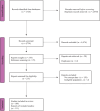A Scoping Review to Identify Clinical Signs, Symptoms and Biomarkers Reported in the Literature to Be Indicative of Biofilm in Chronic Wounds
- PMID: 40389698
- PMCID: PMC12088863
- DOI: 10.1111/iwj.70181
A Scoping Review to Identify Clinical Signs, Symptoms and Biomarkers Reported in the Literature to Be Indicative of Biofilm in Chronic Wounds
Abstract
The objective of this review was to identify clinical signs/symptoms reported in the literature to be indicative of biofilm in chronic wounds. The Preferred Reporting Items for Systematic Reviews and Meta-Analysis extension for Scoping Reviews, and the Joanna Briggs Institute Evidence Synthesis manual guided review conduct. Any article/study type reporting signs/symptoms of biofilm in adults with venous, diabetic, pressure and/or mixed arterial/venous ulcers was eligible. Medline, Embase, CINAHL, Cochrane CENTRAL and the Bielefeld Academic Search Engine were searched. Titles/abstracts and full-text articles were screened against eligibility criteria. One-hundred and eleven reports of 109 articles were included. They provided 830 accounts of clinical signs/ symptoms being indicative of biofilm. These were categorised into 26 statements. Visual indicators such as a shiny, slimy layer on a non-healing wound surface quickly reforming in the absence of frequent cleansing or debridement represented 24% of accounts, followed by failed response to antimicrobial therapies (15%), and failure of wound to close or progress to healing despite optimal management strategies (13%). Wound duration > 6 weeks and extreme tolerance to host defences represented 1% of accounts. Clinical signs/symptoms are recommended and used as indicators of biofilm presence in chronic wounds but with little supporting validation data.
Keywords: biofilms; chronic wounds; scoping review; signs and symptoms; wound healing.
© 2025 The Author(s). International Wound Journal published by Medicalhelplines.com Inc and John Wiley & Sons Ltd.
Conflict of interest statement
The authors declare no conflicts of interest.
Figures





References
-
- Martinengo L., Olsson M., Bajpai R., et al., “Prevalence of Chronic Wounds in the General Population: Systematic Review and Meta‐Analysis of Observational Studies,” Annals of Epidemiology 29 (2019): 8–15. - PubMed
Publication types
MeSH terms
Substances
Grants and funding
LinkOut - more resources
Full Text Sources

